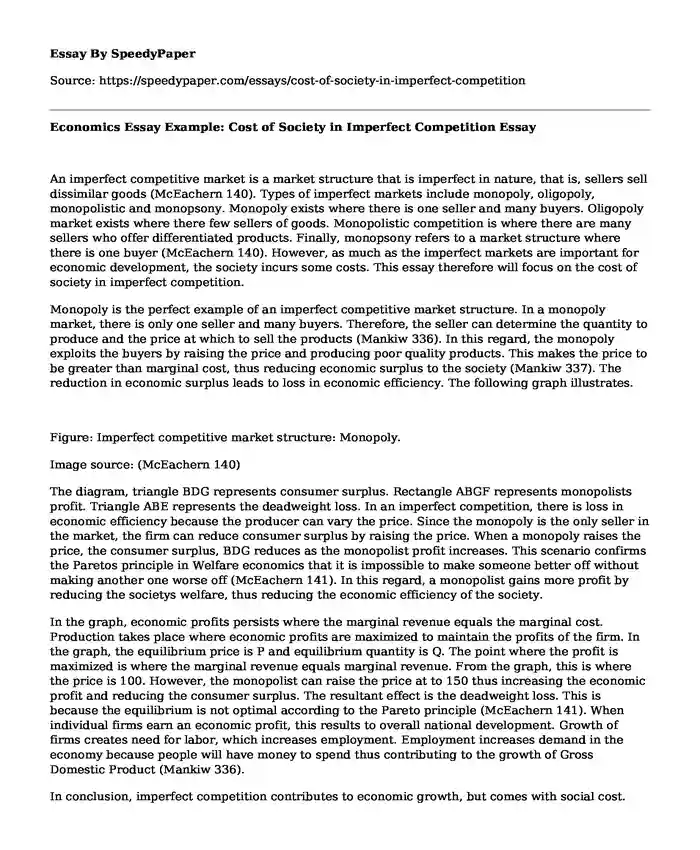An imperfect competitive market is a market structure that is imperfect in nature, that is, sellers sell dissimilar goods (McEachern 140). Types of imperfect markets include monopoly, oligopoly, monopolistic and monopsony. Monopoly exists where there is one seller and many buyers. Oligopoly market exists where there few sellers of goods. Monopolistic competition is where there are many sellers who offer differentiated products. Finally, monopsony refers to a market structure where there is one buyer (McEachern 140). However, as much as the imperfect markets are important for economic development, the society incurs some costs. This essay therefore will focus on the cost of society in imperfect competition.
Monopoly is the perfect example of an imperfect competitive market structure. In a monopoly market, there is only one seller and many buyers. Therefore, the seller can determine the quantity to produce and the price at which to sell the products (Mankiw 336). In this regard, the monopoly exploits the buyers by raising the price and producing poor quality products. This makes the price to be greater than marginal cost, thus reducing economic surplus to the society (Mankiw 337). The reduction in economic surplus leads to loss in economic efficiency. The following graph illustrates.
Figure: Imperfect competitive market structure: Monopoly.
Image source: (McEachern 140)
The diagram, triangle BDG represents consumer surplus. Rectangle ABGF represents monopolists profit. Triangle ABE represents the deadweight loss. In an imperfect competition, there is loss in economic efficiency because the producer can vary the price. Since the monopoly is the only seller in the market, the firm can reduce consumer surplus by raising the price. When a monopoly raises the price, the consumer surplus, BDG reduces as the monopolist profit increases. This scenario confirms the Paretos principle in Welfare economics that it is impossible to make someone better off without making another one worse off (McEachern 141). In this regard, a monopolist gains more profit by reducing the societys welfare, thus reducing the economic efficiency of the society.
In the graph, economic profits persists where the marginal revenue equals the marginal cost. Production takes place where economic profits are maximized to maintain the profits of the firm. In the graph, the equilibrium price is P and equilibrium quantity is Q. The point where the profit is maximized is where the marginal revenue equals marginal revenue. From the graph, this is where the price is 100. However, the monopolist can raise the price at to 150 thus increasing the economic profit and reducing the consumer surplus. The resultant effect is the deadweight loss. This is because the equilibrium is not optimal according to the Pareto principle (McEachern 141). When individual firms earn an economic profit, this results to overall national development. Growth of firms creates need for labor, which increases employment. Employment increases demand in the economy because people will have money to spend thus contributing to the growth of Gross Domestic Product (Mankiw 336).
In conclusion, imperfect competition contributes to economic growth, but comes with social cost. The equilibrium of imperfect market is not Pareto optimal. This means that the firm makes the society worse off in order to gain abnormal profits. For example, a monopoly is able to charge a high price but restrict the quantity produced. This increases the economic profit for the monopoly but reduces the consumer surplus. Therefore, in imperfect competition, in as much as the firm contributes to economic growth, there is economic inefficiency.
Works Cited
Mankiw, N G. Principles of Economics. , 2014. Print.
McEachern, William A. Microeconomics. Mason, Ohio: South-Western, 2011. Print.
Cite this page
Economics Essay Example: Cost of Society in Imperfect Competition. (2019, Oct 11). Retrieved from https://speedypaper.net/essays/cost-of-society-in-imperfect-competition
Request Removal
If you are the original author of this essay and no longer wish to have it published on the SpeedyPaper website, please click below to request its removal:
- Free Essay with the Fight Club Movie Analysis
- Free Essay Example on Interest Groups and Lobbyists in Texas
- Essay Example: The Illusive Eye Exhibition at The Museo Del Barrio NYC
- Essay Example: Patterns in Modernity after WWI
- Communication Tools for EOL Decision-Making, Free Essay Sample
- Free Essay with the Review of Chapter 10: Advertising Whiteness
- Response Essay Example to "Mother Tongue" by Amy Tan
Popular categories





